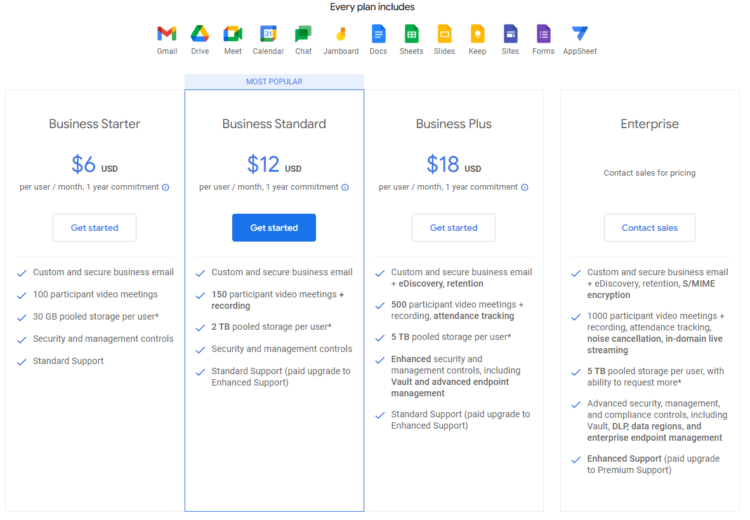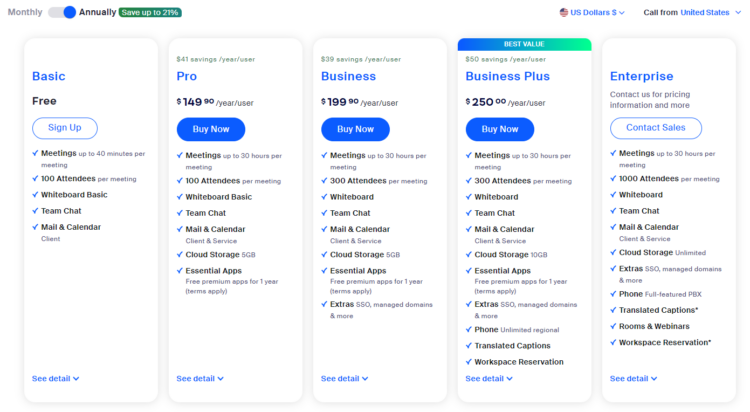
When comparing Google Meet vs Zoom, they have been ongoing competitors as video conferencing has grown in popularity, pushing them to embrace each other’s ideas. Each platform now offers a wide range of functionalities, from screen sharing to virtual backgrounds and breakout rooms. Even their pricing models show similarities. Both offer free versions with limited features and tiered pricing for more advanced needs.
Google Meet capitalizes on its seamless integration with Google Workspace, providing a cohesive user experience and pooled storage options. On the other hand, Zoom provides unrivaled third-party app integration and a more advanced feature set since their only focus is to be the best video conferencing solution possible. Even though there’s a lot in common, when looking at Google Meet vs Zoom, they have some key differences that impact which is best for your business.
Google Meet vs Zoom: Feature Comparison
| Service | Google Meet | Zoom |
| Price | $6 to $18 per user monthly, Enterprise options, paid annually | $12.50 to $25 per user monthly, Enterprise options, cheaper when paid annually |
| Free Version | ✔ | ✔ |
| License Count | Up to 300 users for most plans, Unlimited for Enterprise | 1-9 for Pro, 10-99 for Business, Unlimited for Enterprise |
| Participant Capacity | 100-1,000 depending on plan | 100-1,000 depending on plan |
| Meeting Duration | 60 mins free, 24 hours paid | 40 mins free, 30 hours paid |
| Video Quality | 720p standard, 1080p paid | 680×480 free, 720p to 1080p paid |
| Host Controls | Admit users, mute/unmute, remove, lock, moderate chat, transcription, attendance tracking, reactions | Admit users, mute/unmute, pause videos, lock, record, annotate, manage chat, assign co-hosts, start breakout rooms |
| Screen Sharing | ✔ | ✔ |
| Backgrounds & Filters | Blur, custom backgrounds, filters | Blur, backgrounds, filters, custom avatars, third-party overlays |
| Breakout Rooms | Business Standard plan or higher | ✔ |
| Waiting Room | ✔ | ✔ |
| Calendar Integration | Google Calendar and third-party | Multiple third-party options |
| Cross-Device Access | Browser, mobile, Workspace, smart displays | Browser, desktop, mobile, Zoom Rooms, smart devices, VDI |
| Dial-in Feature | ✔ | Paid plans only |
| Recording Options | Paid plans, cloud recording | All plans, local and cloud recording |
| Cloud Storage | 30GB-5TB of pooled storage; 15GB free | 5GB-10GB, extra purchasable, no free |
| Whiteboard | Google Jamboard | Built-in |
| Polling | Business Standard plan or higher | All paid plans |
| Q&A | Business Standard plan or higher | All paid plans |
| Attendance Tracking | Business Plus plan or higher | All paid plans |
| Hand Raising | Google Standard plan or higher | ✔ |
| Closed Captioning | ✔ | ✔ |
| Meeting Transcripts | ✔ | Business plan or higher |
| App Integrations | Google Workspace, 200+ third-party apps for Google Meet | 1,500+ third-party apps |
| Security | Anti-hijacking, DTLS/SRTP, 2FA, data encryption, privacy & compliance, incident response, Advanced Protection Program | TLS/AES-256, E2EE, 2FA, host controls, watermarking, advanced chat & audio encryption, managed domains |
| File Sharing | Via Google Drive | Direct file sharing |
Pros and Cons of Google Meet

To expand upon our Google Meet vs Zoom comparison, we’ll highlight some key pros and cons to keep in mind when considering both options.
Pros of Google Meet
- User-Friendly: Google Meet’s straightforward navigation ensures that users can focus on the meeting rather than juggling too many different features, settings, or applications to get a complete experience.
- Great Free Version: Google Meet’s free version is feature-rich, offering a 60-minute meeting duration, user-friendly controls, and 15GB of storage, making it an excellent option for budget-conscious users or small teams.
- Google Workspace Synergy: For organizations already invested in Google’s ecosystem, Google Meet offers seamless integration, making it easier to schedule meetings, share files, and collaborate in real time.
- Pooled Storage: Google Meet offers pooled storage, providing a flexible cloud storage solution that balances high-usage and low-usage employees without extra costs. Free users get 15GB of storage.
- Advanced Protection Program: Google Meet users can enroll in the Advanced Protection Program for enhanced security measures against phishing and account hijacking.
Cons of Google Meet
- Google Workspace Dependency: While Google Workspace integration can be a strength, it’s also a limitation for businesses that don’t want to be tied into Google’s ecosystem. The full feature set of Meet is most effectively utilized when using other Google services.
- Basic Chat Functionality: Google Meet’s in-meeting chat lacks some of the more advanced features offered by Zoom, such as code snippet sharing or built-in file transfer beyond Google Drive.
- Limited External Apps: While Google Meet integrates tightly with Google Workspace, its options for third-party app integrations are limited compared to Zoom.
Pros and Cons of Zoom

Having looked at the pros and cons of their video conferencing competitor, we’ll explore the other side of Google Meet vs Zoom.
Pros of Zoom
- Comprehensive Feature Set: Zoom’s features allow for a highly interactive and versatile meeting experience for both hosts and users.
- Broad Third-Party Integrations: Zoom offers extensive third-party app integrations, over 1,500 in total, providing a highly customizable user experience.
- User-Friendly Interface: Zoom’s intuitive design makes it accessible for users of all skill levels. Its straightforward layout streamlines setting up and joining meetings, enhancing the overall user experience.
- Advanced Host Controls: With features like pausing participant videos and annotation during screen sharing, Zoom gives hosts more control over meetings.
- Standalone Versatility: Zoom operates as a standalone platform. This allows businesses and users greater flexibility, as they’re not connected to a specific productivity suite. That makes Zoom a versatile choice for those who use a mix of software and services for their operations.
- Desktop App: Unlike Google Meet, which doesn’t have a native desktop application, Zoom provides a desktop app that offers full functionality, appealing to those who prefer standalone software.
Cons of Zoom
- Higher Pricing: Compared to Google Meet, Zoom’s pricing can be higher, especially for top-tier plans. Some core and extended features, like Zoom Scheduler, are locked behind additional add-on expenses.
- Limited Storage: Zoom’s cloud storage is per user, not pooled, and offers a low amount for non-enterprise plans. There’s also no cloud storage provided to free users, unlike Google Meet.
- Past Security Concerns: Zoom faced a class-action lawsuit after claiming to offer end-to-end encryption, which was later found to be inaccurate. Zoom has since enhanced its security measures, though this history may raise concerns for users prioritizing data protection and transparency.
Google Meet vs Zoom: Which Is Best for You?
When comparing Google Meet vs Zoom, it comes down to what your organization needs most: budget-friendliness, unique features, or scalability. Both platforms have evolved to offer a wide range of user-friendly features. However, they each have distinct advantages and limitations that could tip the scales depending on your specific needs.
The Case for Google Meet
Google Meet is often the more economical option if you’re running a small business or working with a tight budget. It offers competitive pricing plans, a free version with a 60-minute meeting limit, and easy-to-use host controls. Plus, if you’re already using Google Workspace, Google Meet integrates seamlessly, adding value to your existing setup. But be aware: this strong tie to Google Workspace could be a drawback if you’re not interested in fully adopting Google’s ecosystem.
The Case for Zoom
On the flip side, Zoom offers robust features and advanced host controls, making it ideal for more complex meeting setups. It also boasts a wide variety of third-party app integrations, giving businesses more customization options. But these perks come at a cost and potentially a learning curve to best use more advanced features. And while Zoom does offer some level of integration with Google Workspace, it doesn’t quite match the native, seamless experience you’ll get with Google Meet.
Google Meet vs Zoom: What’s Best Depends on Your Needs
In summary, Google Meet tends to be a better fit for small businesses and those looking for a cost-effective, straightforward solution that works well with Google Workspace. It’s also great for those who only host meetings infrequently. Zoom is better suited for larger organizations that require a more feature-rich and customizable experience, albeit at a higher price point. As you consider Google Meet vs Zoom, compare the features and cost, and go with what offers the most value based on your video conferencing needs.
Does your business want to integrate video conferencing, but you’re unsure where to start? Get in touch with one of our IT consultants via our contact form or call us at +1 (800) 297-8293




















